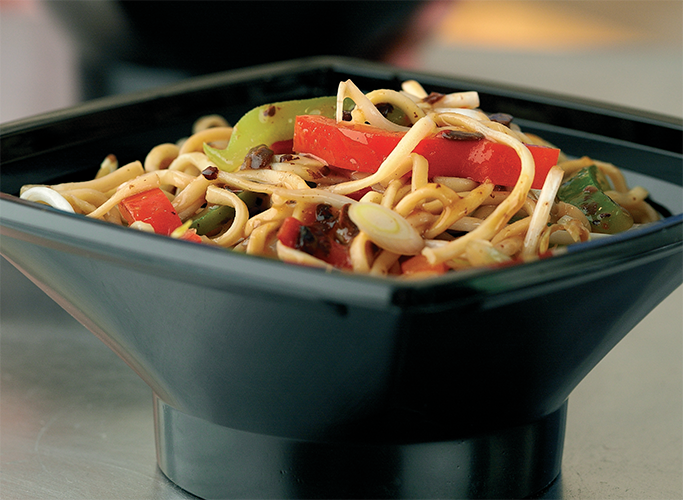
Anson Packaging
Closing the loop
A comprehensive understanding of the food industry is giving Anson Packaging the edge within the thermo-forming market
Anson Packaging is the leading producer of rigid tray packaging solutions, as well as a variety of bespoke and standardised products within the food industry. With over 30 years of operating history generating from a family-owned business, the company currently has a turnover of £33 million, and has recently implemented a three-year business plan to increase this to £50 million. Anson thermoforms plastic sheets into packaging solutions such as trays, containers, and plastic enclosures for retailed food products. Employing over 300 people, the company has three facilities across the UK: its primary production sites at Haddenham and Sutton and also Anson’s head office are all based in Cambridgeshire. The company is undertaking a significant development programme to expand its facilities, as well as adapt and install machinery that uses recyclable materials.
Paul Greenhow has recently joined Anson this year after previously working extensively with the food and retail industries, and has been able to apply his knowledge of the industry to the company’s development. Paul outlines the current direction of the business: “Anson operates in three key categories: the first are the more mature markets like bakery and confectionary goods. An emerging market for Anson is the convenience sector, by which I mean the chilled prepared foods category – the company is heavily involved in producing products for salads, multi-pack dip trays, snack pots, and patisserie goods.”
Paul is keen to explain three key strategies that guide Anson’s operations at the moment: “The first is low cost production, with an investment in the most modern manufacturing techniques, in order to reduce its cost base. The second strategy is the use of sustainable materials: the packaging industry is currently in the limelight through the debate regarding the reduction of packaging, so Anson has installed a programme that will focus on the development of biopolymers, which are non-oil based. One of these materials is called Plantic, and the other is known as PLA – both these products are made from sustainable resources, particularly cornstarches. Anson is also looking into packaging made from recycled materials, working with retailers and local authorities to collect post-consumer waste, and reintroduce this into the company’s manufacturing process. Anson is now in the position to launch products known as R-PET 50, which contain 50 per cent recycled materials in the finished product.
“The third strategy area is innovation, which is predominantly driven by Anson’s design and development team, containing ten individuals ranging from concept to
product designers. The team takes an array of briefs, with two primary areas of focus. Bespoke products are designed for retail customers, and the other area of focus is on future trends and potential innovations.” These strategies are falling into line with the company’s environmental approach to the manufacturing of its products, as Paul elaborates: “Anson was predominantly a producer of PVC, yet the company has come to the belief that PVC is not the future of plastic packaging, with PET being the right direction in terms of the environment. Therefore, Anson is
converting its Sutton factory to a PET-only site, not producing any PVC at all. All of the company’s machines are able to handle PET, as this is the material Anson believes will be at the forefront of the market. Anson is doubling the capacity of its warehouses as well to cope with the growth. “The company has attained a licence to use Plantic and PLA in its factories, but there are more immediate concerns that need to be addressed in closing the loop in the recycling process, as Paul understands: “Anson has included these biopolymer materials as part of its
innovative processes, and its drive has focused on the recycling possibilities of the products. The issue at the moment is the amount of recycled materials that are being collected – Anson wants its machines to use recycled post-consumer waste specifically, but the infrastructure is not available in the UK for this to happen. The more recycling that takes place, the more PET Anson has, and the more landfills are reduced. The company is developing a strategy to investigate how it could collect a retailer’s materials, and manufacture it as part of a closed loop process between both companies. The company thrives on close working relationships, and wants to develop agreements with its customers to be able to recycle all its packaging once it has been used, manufacturing a new range of R-PET 50 postconsumer waste products.”Paul comments on the outlooks of the company:
“Anson is always looking to develop the standard of its range, and it is always looking to progress the scale of its designs. The company aims to get into supply partnerships with some of its more major customers, and Anson is always designing bespoke products alongside these companies. Anson’s strength as a business is its financial fortitude, and therefore in relation to its strategies, the company is in a strong position because of the quality of its facilities, recycling programme, and the sustainable materials is uses. Anson believes that investment is the future, and is in a current position to ensure this direction is upheld. Through investment, the company will still be a major player in the thermo-formed plastic market in five to ten years time.”
On his role in the company, Paul states: “My background is in the food industry, so my experience gives the company and understanding of the retail industry, and the supply of food packaging. Packaging is the first, and most integral, part of the food supply chain, and my role will be to develop Anson in relation to the needs of the food industry, and to drive the customer focus element of the business. The plastic industry is tough, but with my knowledge of the food industry, I believe I can give Anson the competitive edge within the market,” he concludes.